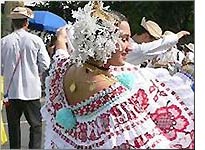| |
LA POLLERA FESTIVAL
Date: July 22nd. Place: Las Tablas, province of Los Santos.
 La Pollera, is Panama´s traditional costume. The "La Pollera National Festival", was officially created in July of 1957 and is celebrated each year on July 22nd, within the framework of the Santa Librada Patron Saint Festival in the city of Las Tables, province of Los Santos. The festival´s objective is to highlight Panama´s national costume, promote its correct use and outline the work of the arts and crafts of the province. The women that take part in the festival have the privilege that many of them can selected the La Pollera National Queen. Parallel to this contest there are other contests like the Violin National Contest, the Camisilla and Sombrero in addition to other exhibitions and folkloric activities. La Pollera, is Panama´s traditional costume. The "La Pollera National Festival", was officially created in July of 1957 and is celebrated each year on July 22nd, within the framework of the Santa Librada Patron Saint Festival in the city of Las Tables, province of Los Santos. The festival´s objective is to highlight Panama´s national costume, promote its correct use and outline the work of the arts and crafts of the province. The women that take part in the festival have the privilege that many of them can selected the La Pollera National Queen. Parallel to this contest there are other contests like the Violin National Contest, the Camisilla and Sombrero in addition to other exhibitions and folkloric activities.
PANAMANIAN CARNAVAL
Date: February
Carnavals in Panama is the most important festival of the year, its popularity is comparable with the famous Brazilian carnavals both in participation and enjoyment as well as its costumes and folkloric presentations. The carnavals are always celebrated the Tuesday before Ash Wednesday lasting four days and five nights, where creativity and talent of the costume designers make the event an international attraction. This event can be divided into two geographic zones: Carnavals from the provinces of the Republic and those of the capital city; the first is characterized for its luxury and spendor, the most famous of them all is the Las Tablas carnavals in the province of Los Santos. While the carnavals in the capital city has already taken up its own identity with its own folklore and cultural projection. The Carnaval in general is reason for inspiration and takes up its regional identity including its food, the stories of the older generation that continue conserving its own history and traditions.
LA MEJORANA FESTIVAL
Date: September 23-29. Place: Guararé, province of Los Santos.
This festival has been held for over 50 years and continues to cultivate Panamanian folklore while protecting the vernacular customs of the inhabitants in the country´s small towns. The festival includes: musical presentations, contests, folkloric dances, bull fighting, popular dances among other artistic expressions. Guararé, a cozy and musical town turns each September into a host of folkloric groups and visitors that participate in this great national Panamanian festival.
MANITO FESTIVAL
Date: August 18-22 Place: Ocú, province of Herrera
This folkloric event where autochthonous traditions are represented by campesinos of the past century, honors the “ocueño campesino” who are the true “manitos”. The people from the countryside had and still has the tradition of greeting people saluting with the hands and taking them to the forehead and they say “ta las manito”, from here its name. At the time, the people that lived in the countryside had a way of carrying out their activities, inherited from Spain which had installed in the region. These customs were picked up by the region’s teachers and each year they are remembered at the Manito Festival.
CORPUS CHRISTI FESTIVAL
Date: June.
Religious festival held nationally.
TORITO GUAPO FESTIVAL
Date: October. Place: Anton Valley
The Toro Guapo Festival is a Panamanian tradition born in 1964 on the proposal by a professor, who has passed away, with the intention of learning the customs and folkloric features of the region in order to preserve them. It is a party of dances, parades, contests, blessings and bull fighting across the church among other artistic and recreational activities.
DIABLOS AND CONGOS FESTIVAL
Date: February. Place: Portobelo, province of Colon.
One of the people’s main traditions is the drum of the “Congos”. Generally happens during the carnavals in the month of February. This tradition dates back to the time of the slaves during the colonial period. It was a lack of respect for the Spanish kings and during the dance which last for several days, the participants assumed the role of slaves at large escaping from the Spanish. They hid in different parts of the town and took up captives.The dance includes personalities that represent the congos fighting against the “Devil”, who was loose for days. At the end they are saved by the “congo queen” with the help of other personalities representing the good like “a bird” and “Juan de Dios”. In this tradition it is difficult to observe syncretism, between the Catholic and African religions.
BLACK CHRIST OF PORTOBELO FESTIVAL
Date: October 21. Place: Portobelo, province of Colon.
On this date, Portobelo is turned into one of the most important religious traditions in Panama. It deals with the festival of the Black Christ where thousands of the country’s followers gather in the town.
Many go walking from far places to pay favors from the Nazareno milagroso. Others arrive on their knees or carrying a heavy cross in penitence.
|
|